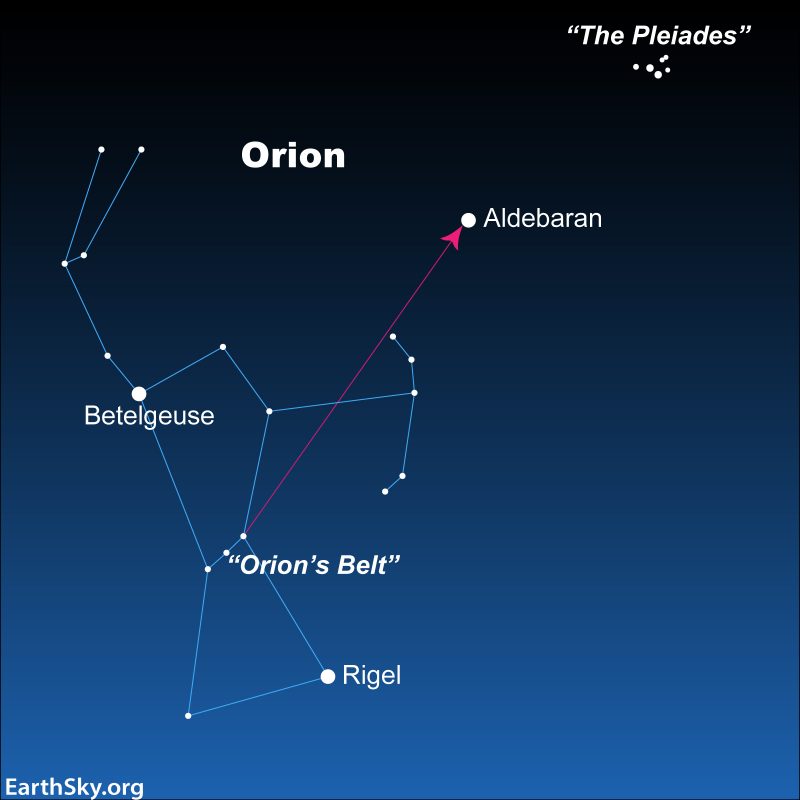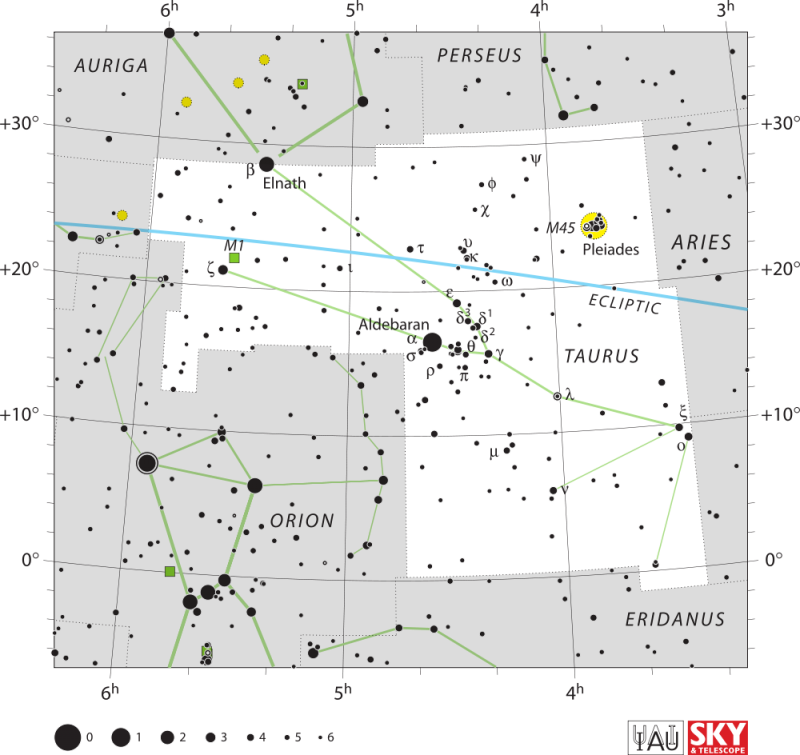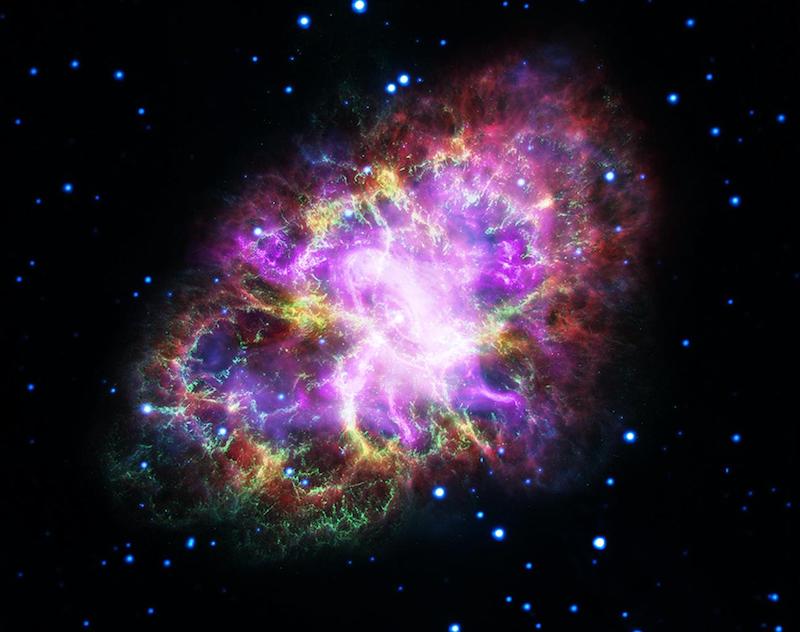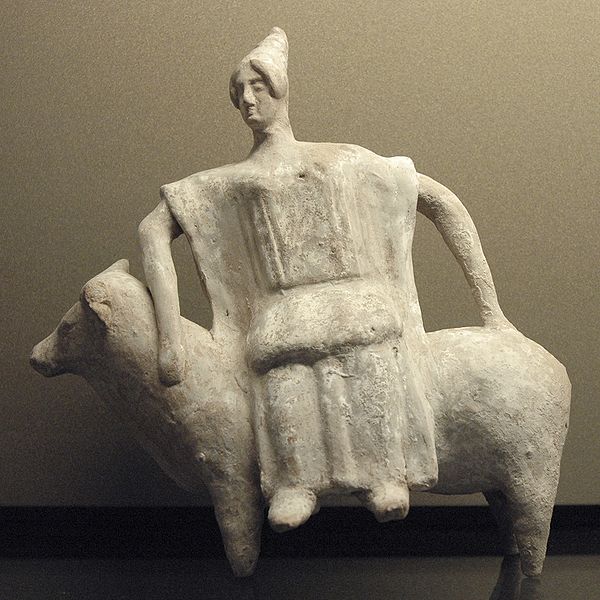
Taurus the Bull
The constellation Taurus the Bull is visible during the fall through spring in the Northern Hemisphere (or spring through fall in the Southern Hemisphere). It sits in the evening sky close to the easy-to-see constellation Orion.
Basically, Taurus the Bull takes the shape of a two-pronged fork, with the center V-shape consisting of an actual star cluster – a family of stars in space – that we call the Hyades. The Hyades marks the face of the Bull. The bright red star Aldebaran shines in the V, and represents the Bull’s fiery eye. In addition, Taurus holds another famous star cluster, which we call the Pleiades or Seven Sisters. It has the shape of a tiny dipper.
Moreover, Taurus is also the radiant point for the annual Taurid meteor shower, which happens every year in November.
Last chance to get a moon phase calendar! Only a few left. On sale now.

Locating Taurus the Bull
Taurus is a constellation of the zodiac, which means the sun, moon and planets travel through it regularly. The sun passes through the constellation Taurus from about May 14 to June 21. You can’t see Taurus when the sun is within its borders, however.
Generally speaking, Taurus is easy to find on its own. That’s because of the two star clusters, the V-shaped Hyades and small but distinctive stars of the Pleiades. However, if you orient yourself with the famous constellation of Orion, you’ll know you’re looking in the right place.
First, find Orion by looking for its three Belt stars. Orion and Taurus are next-door neighbors on the sky’s dome. In fact, Taurus rises above the horizon first. So by the time Orion is risen, you can use its Belt stars to draw a line upward to find Aldebaran and the two clusters of Taurus.

The stars of the Bull
Furthermore, Taurus is home to two particularly bright stars: Aldebaran and Elnath. Aldebaran is the easier of the two to find because it’s brighter, it’s part of the V-shape of the Hyades and it has a reddish hue.
For good reason, stargazers think of Aldebaran as the Bull’s fiery eye. Aldebaran is the 14th brightest star in the sky. It shines at magnitude 0.85. Although it may look like part of the Hyades cluster, it’s much closer. Aldebaran lies 65 light-years distant. The other stars of the Hyades are about 150 light-years away.
Elnath marks the end of one of Taurus the Bull’s horns. It’s on the opposite side of the Bull’s head from Aldebaran. Elnath is the 2nd brightest star in Taurus after Aldebaran. It shines at magnitude 1.68. Relatively nearby, Elnath lies about 130 light-years away, in the direction of the Milky Way’s anticenter.

The Crab Nebula
In addition, Taurus holds an excellent deep-sky target that binoculars or small telescope owners can spot. Messier 1, or the Crab Nebula, is what’s left of a star after it exploded in a supernova. As a result, it lit up the daytime sky for over a month in 1054 AD.
The Crab Nebula shines at magnitude 8.4. It lies near a star in Taurus named Zeta Tauri. While Elnath is the point of one of thebhorns, Zeta Tauri is the other.

Taurus the Bull in mythology and timekeeping
According to Greek mythology, the constellation Taurus commemorates the god Zeus. Zeus changed himself into a beautiful white Bull to win the affections of the Phoenician princess Europa. After Europa hopped onto the Bull’s back, the Bull swam across the Mediterranean Sea, taking Europa all the way to the island of Crete. Later, Zeus and Europa became the parents of Minos, the legendary king of Crete.
Meanwhile, the Zuni of New Mexico used the Pleiades cluster as an agricultural calendar. When the Pleiades – which the Zuni called the Seed Stars – disappeared into the western dusk in spring, they knew it was safe to plant their seeds, as the danger of frost had passed. However, the Zuni also knew the planting must be done before the Pleiades reappeared in the east before sunrise. Otherwise, immature plants would succumb to autumn frosts.
The Zuni were hardly alone in their reverence for the Pleiades star cluster. Indeed, probably no other star formation has enjoyed such worldwide renown for timekeeping, celebration and storytelling.

Bottom line: Taurus the Bull resides near the constellation Orion. It contains two famous star clusters that are easy to spot: the Pleiades and the Hyades.
The post Meet Taurus the Bull in the evening sky first appeared on EarthSky.
from EarthSky https://ift.tt/K5RlfAC

Taurus the Bull
The constellation Taurus the Bull is visible during the fall through spring in the Northern Hemisphere (or spring through fall in the Southern Hemisphere). It sits in the evening sky close to the easy-to-see constellation Orion.
Basically, Taurus the Bull takes the shape of a two-pronged fork, with the center V-shape consisting of an actual star cluster – a family of stars in space – that we call the Hyades. The Hyades marks the face of the Bull. The bright red star Aldebaran shines in the V, and represents the Bull’s fiery eye. In addition, Taurus holds another famous star cluster, which we call the Pleiades or Seven Sisters. It has the shape of a tiny dipper.
Moreover, Taurus is also the radiant point for the annual Taurid meteor shower, which happens every year in November.
Last chance to get a moon phase calendar! Only a few left. On sale now.

Locating Taurus the Bull
Taurus is a constellation of the zodiac, which means the sun, moon and planets travel through it regularly. The sun passes through the constellation Taurus from about May 14 to June 21. You can’t see Taurus when the sun is within its borders, however.
Generally speaking, Taurus is easy to find on its own. That’s because of the two star clusters, the V-shaped Hyades and small but distinctive stars of the Pleiades. However, if you orient yourself with the famous constellation of Orion, you’ll know you’re looking in the right place.
First, find Orion by looking for its three Belt stars. Orion and Taurus are next-door neighbors on the sky’s dome. In fact, Taurus rises above the horizon first. So by the time Orion is risen, you can use its Belt stars to draw a line upward to find Aldebaran and the two clusters of Taurus.

The stars of the Bull
Furthermore, Taurus is home to two particularly bright stars: Aldebaran and Elnath. Aldebaran is the easier of the two to find because it’s brighter, it’s part of the V-shape of the Hyades and it has a reddish hue.
For good reason, stargazers think of Aldebaran as the Bull’s fiery eye. Aldebaran is the 14th brightest star in the sky. It shines at magnitude 0.85. Although it may look like part of the Hyades cluster, it’s much closer. Aldebaran lies 65 light-years distant. The other stars of the Hyades are about 150 light-years away.
Elnath marks the end of one of Taurus the Bull’s horns. It’s on the opposite side of the Bull’s head from Aldebaran. Elnath is the 2nd brightest star in Taurus after Aldebaran. It shines at magnitude 1.68. Relatively nearby, Elnath lies about 130 light-years away, in the direction of the Milky Way’s anticenter.

The Crab Nebula
In addition, Taurus holds an excellent deep-sky target that binoculars or small telescope owners can spot. Messier 1, or the Crab Nebula, is what’s left of a star after it exploded in a supernova. As a result, it lit up the daytime sky for over a month in 1054 AD.
The Crab Nebula shines at magnitude 8.4. It lies near a star in Taurus named Zeta Tauri. While Elnath is the point of one of thebhorns, Zeta Tauri is the other.

Taurus the Bull in mythology and timekeeping
According to Greek mythology, the constellation Taurus commemorates the god Zeus. Zeus changed himself into a beautiful white Bull to win the affections of the Phoenician princess Europa. After Europa hopped onto the Bull’s back, the Bull swam across the Mediterranean Sea, taking Europa all the way to the island of Crete. Later, Zeus and Europa became the parents of Minos, the legendary king of Crete.
Meanwhile, the Zuni of New Mexico used the Pleiades cluster as an agricultural calendar. When the Pleiades – which the Zuni called the Seed Stars – disappeared into the western dusk in spring, they knew it was safe to plant their seeds, as the danger of frost had passed. However, the Zuni also knew the planting must be done before the Pleiades reappeared in the east before sunrise. Otherwise, immature plants would succumb to autumn frosts.
The Zuni were hardly alone in their reverence for the Pleiades star cluster. Indeed, probably no other star formation has enjoyed such worldwide renown for timekeeping, celebration and storytelling.

Bottom line: Taurus the Bull resides near the constellation Orion. It contains two famous star clusters that are easy to spot: the Pleiades and the Hyades.
The post Meet Taurus the Bull in the evening sky first appeared on EarthSky.
from EarthSky https://ift.tt/K5RlfAC

Aucun commentaire:
Enregistrer un commentaire